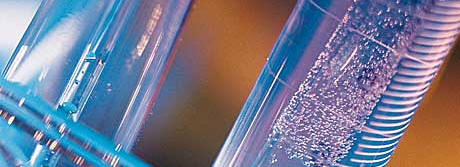
|
Eugene Dakin Ph.D., P.Chem Professional Chemist
|
|
|
|
|
Sulphur Chemistry This large area of chemistry addresses the removal of various forms of sulphur from produced hydrocarbons. The areas of petroleum and petrochemicals are required to meet lower specifications for hydrogen sulphide (H2S) emissions and in sales gases and liquids. Further complicating these requirements are shrinking budgets which lowers available capital for projects.
Chemistry is the answer to these restrictions on sales criteria and budgets.
How can this be?
With chemistry, the removal of material is based on production. For example, when production is shut down or is interrupted for one reason or another, no chemical is being used since production = zero, and cost = zero. With a capital expense, the business is paying for the material IF PRODUCTION IS OR IS NOT OCCURRING. When production = 0, cost = high $$. Chemical treatment also lowers available Iron Sulphide which can be spontaneously combustible when exposed to air.
In a perfect world, industrial plants and treating systems are not producing in times of scheduled maintenance. However, unscheduled shutdowns are usually not the norm.
Many available chemical treatment strategies exist: 1) H2S Scavenging 2) Combined H2S and CO2 removal 3) Elemental Sulphur creation
H2S Scavenging Hydrogen Suphide Scavenging is the selective removal of H2S without removing Carbon Dioxide (CO2). The general reaction is: H2S + Scavenger => H2S-Scavenger There are MANY different types of scavenger that cause precipitation, are corrosion inhibitors, and vary widely in efficiencies and operate at various pressures. Most applications are for removing hydrogen sulphide from natural gas sales streams or liquid in which the sulphur content must be in the range of 0.1 - 5.0 part per million. This is completed without removing Carbon Dioxide from the system which can be Slipstreamed or passed through the system to accompany the sales gas.
Combined H2S and CO2 Removal This chemical process removes both acid gases simultaneously from the natural gas stream. When low Hydrogen Sulphide levels (0.1 to 5.0 ppm) and Carbon Dioxide (<2.0 %) are required for meeting sales specifications.
The general reactions are: H2S + Scavenger => H2S-Scavenger CO2 + Scavenger => CO2-Scavenger
Lowering the levels of these acid gasses also limits/lowers: corrosion, off-specification gas, injury to operations personnel.
Elemental Sulphur Removal/Recovery Removal and recovery is traditionally accomplished using oxygen and sulphur in the chemical reaction that creates solid sulphur. Recovered sulphur is then sold to manufacturers in other chemical industries such as: Battery manufacturers, drug creation, paints, cleaners, and other areas.
The reaction is as follows: H2S + 1/2 O2 => S(s) + H2O
Oxygen from the atmosphere is injected into a hydrogen sulphide stream in the presence of a chemical catalyst (usually designed by a metallurgical chemist) to cause reduction (formation) of solid sulphur at an elevated temperature. Pure sulphur has a melting temperature of 112.8 Celsius (~235 Fahrenheit), and must be kept above this temperature in order for the sulphur to remain in a liquid state.
Summary A flexible solution approached with common sense based on the final system will provide the maximum uptime. Be concerned of vendors who want to sell a generic system without examining all of the facts. Ensure that the company employs licensed professional chemists for your chemical solutions. Would you want a non-licensed mechanic fixing your car?
Contact Eugene for more information.
|
|
| © 2006 - Eugene Dakin -
|
